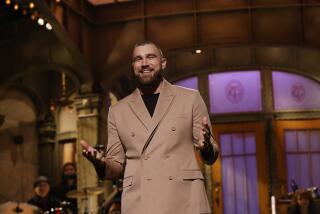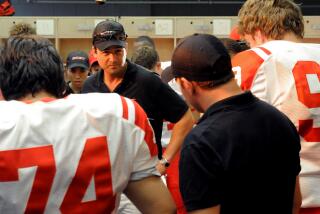‘Friday Night Lights’: A series worth cheering about
It is unfortunate that when it comes to television programs, the shows that get the most attention are those that call the most attention to themselves -- the ones that are quirky, odd and flamboyant. With none of those qualities, “Friday Night Lights,” which is now running its fourth season on Direct TV and will be returning to NBC prime time on April 30, has sort of flown under the radar.
Though it has received critical plaudits, won a Peabody Award, a Television Critics Assn. awards and an Emmy, it has never received an Emmy nomination for outstanding dramatic series and none of its cast members has been nominated. Also, its ratings have always been problematic and it has twice been on the brink of cancellation. (Hence the deal between Direct TV and NBC to share costs.)
Still, at a time when NBC is being vilified, here is one thing it has done right. Despite paltry ratings, it has continued to support what may be the best dramatic series in the history of television. That’s right: history.
The provenance of “Friday Night Lights” is H.G. Bissinger’s now-classic 1990 book of the same name that followed a year in the life of Odessa, Texas, and of the oil town’s perennially superb high school football team, the Permian Panthers. Bissinger’s Odessa was desolate -- physically and spiritually parched. It was racked by boom-and-bust oil cycles, by bigotry and racial division, by misplaced educational priorities and by a general sense of doom. What it had was the Permian Panthers to fill its existential void as they filled its 20,000-seat stadium on Friday nights during football season. As Bissinger quotes one booster, “Life really wouldn’t be worth living if you didn’t have a high school team to support.”
The book became a 2004 movie starring Billy Bob Thornton as Coach Gary Gaines, directed by Bissinger’s cousin, Peter Berg, and it was Berg who turned it into a series two years later because, he said, there were so many avenues the movie just couldn’t pursue. The movie and the series both retained the book’s sense of football as transcendent: a great barbaric yawp against the world and the town’s only equalizer with people and communities that had so much more.
But Bissinger’s was a work essentially of sociology. He was fascinated with the way football served not only as an escape from Odessa’s travails but as a window on them. The series confronts racism, class distinctions, crime, drugs and those misplaced priorities among other things, but it is deeply personal. It is fascinated less with the community than with individuals.
Of course, high school football is still at the center of -- and even the apex of -- the fictional West Texas town of Dillon. Town life swirls around the Dillon Panthers, and the coach’s job security hangs on every game. But the power of the series is that it isn’t really about football or even about the way football allows these young men -- and the middle-aged fans who live vicariously through them -- to experience transcendence. Bissinger quotes one parent, “It’s Camelot for them. But there’s even life after it.” “Friday Night Lights” shows what comes after Camelot. It is a series about surviving, not winning.
Much has been made of the series’ realism, of how close it seems to get to the nub of life. In directing the pilot, Berg opted for: a hand-held camera (the early shows were so jiggly NBC asked him to pull back a bit); shooting entirely on location in Texas with largely local extras; following the actors with the cameras, rather than blocking for the camera as most series do; and letting actors improvise dialogue. That seemingly artless style has become the series’ trademark. On “Friday Night Lights” you seem to be glimpsing life itself, not watching a television show. Even the show’s melodrama seems honest -- the heightened reality of teenagers groping their way through life.
But its stylistic tics could be affectation if they weren’t so thoroughly integrated with the show’s themes. Most series, indeed most dramas, rely on clear objectives, daunting impediments and a satisfying resolution. “Friday Night Lights,” like life itself, has none of these. The objectives are uncertain, the impediments nearly metaphysical and no resolutions are in the offing. Without this clarity, there is something ineffably sad and tearful about “FNL,” which is why, along with those football highs, it may have the greatest emotional range of any series ever on television. It can be at turns triumphant and heartbreaking, though heartbreaking prevails.
In this, “Friday Night Lights” may owe as much to Peter Bogdanovich’s 1971 film “The Last Picture Show” as to Bissinger’s book. Everyone in Dillon seems to realize, even if only subconsciously, that those football highs are temporary and that the miasma of Dillon may be permanent. Everyone seems to realize that the very best of life may be those four years playing Panthers football with a crack at the state championship, and that everything after that is anticlimactic. And everyone seems to realize that the dreams they harbor are likely to be unfulfilled.
Hope comes hard. Like the town in which they live, nearly all of the characters are thwarted: Jason Street, the all-state quarterback headed to Notre Dame, breaks his neck on the first show; his replacement, sophomore Matt Saracen, is tentative about football and most other things; Street’s best friend, fullback Tim Riggins, is a handsome and bighearted but promiscuous lout with no ambition; Riggins’ former girlfriend, Tyra Collette, coasts through life trying to shake her bad-girl reputation; Street’s girlfriend, town beauty Lyla Garrity, has her life derailed by his injury; Smash Williams, the star running back, wrestles with whether he has the size to succeed at college football, his only ticket out of Dillon.
If nearly every character is thwarted, nearly every one is also adrift. There are few intact families on “Friday Night Lights.” Riggins has been abandoned by his parents and lives with his older brother. Saracen’s mother was driven out long ago by his father, who is on military duty in Iraq, and he lives with his increasingly dotty grandmother. Tyra’s father is long gone, and she lives with her mother and sister. Lyla’s father, the Panthers’ most gregarious booster, is booted out by her mother after he has a brief affair. Williams’ father is dead.
It would be easy enough for the series itself to drift from crisis to crisis, but with its ongoing sense of dislocation and blight, the central focus is not just the flow of life or even the things that daily circumscribe life but the basic question of how to live, how to make it through a life in which there probably won’t be a post-adolescent touchdown or championship. Therein may lie the series’ true claim to greatness.
Other programs have approximated reality -- “My So-Called Life,” “Southland,” “Men of a Certain Age,” to name three -- even if they haven’t done quite as well. Others have attempted to capture the moments and rhythms of life. But “Friday Night Lights” is one of the most lifelike works of art in any medium not because, with its hand-held camera and its improvisations, it looks and sounds like life but because it has embraced the deeper uncertainties of life and because it addresses without any dramatic bombast how people try to cope with them.
The major point of departure between the series and its two “FNL” forebears is the fictional couple Coach Eric Taylor and his wife, Tami, the high school guidance counselor and later its principal. Coach Gaines of Odessa was a coach, as besotted with football as everyone else in the town because his livelihood depended on it. The Taylors, unerringly played by Kyle Chandler and Connie Britton, on the other hand, are the moral and physical center of Dillon as well as the stars of the show. Eric Taylor is no saint. He will do what is in the best interests of his team even when it is not always in the best interests of one of his players.
But grave and unflappable, Taylor also seems to appreciate the metaphoric nature of football and he is the one character on the show who has come to terms with it. He understands that football isn’t the way out of a dead-end life; at best it can provide a lesson for justifying a life. The team’s chant -- “Clear eyes, full hearts can’t lose” -- is obviously not just a rallying cry; it is his guide to survival.
So why is it that a series that ranks among the best works of recent American art is always struggling to find an audience? NBC at first blamed itself for driving away female viewers by emphasizing football rather than the show’s personal drama, though a subplot involving an accidental homicide in Season 2, one that seemed clearly intended to raise the dramatic stakes, had some of the show’s admirers claiming it had jumped the shark -- a premature judgment, it turned out. Berg blamed the scheduling that pitted “FNL” against “Dancing With the Stars” and “ American Idol.”
But the truth may be that the assets that make “Friday Night Lights” so miraculous may also ensure that it will not attract the number of viewers it deserves. It is, after all, a quiet series that examines the increments of life. A huge splash would be incongruous for a show that tells us there really are no huge splashes, no clear paths and no definitive answers -- a series that tells us it’s all about clear eyes and full hearts. It is not the grand gestures, says “FNL,” that finally make life worthwhile, but the small ones. So it is with great series too.
Neal Gabler is the author of “An Empire of Their Own: How the Jews Invented Hollywood,” “ Walt Disney: The Triumph of the American Imagination” and other books.
More to Read
The complete guide to home viewing
Get Screen Gab for everything about the TV shows and streaming movies everyone’s talking about.
You may occasionally receive promotional content from the Los Angeles Times.






